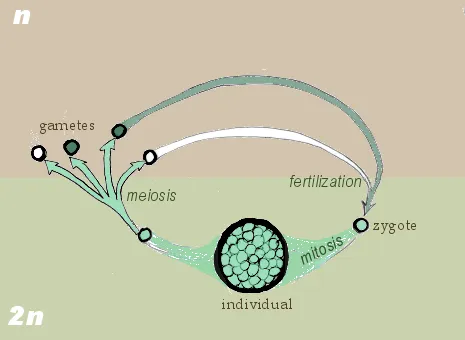Hello, welcome to another exciting episodes
As you well know genetics is defined as the scientific study of heredity and variation in living things. While heredity or inheritance is defined as the transmission and expression of characters or traits in organisms from parents to the offspring. And variation is defined as the differences which exist between parents and offspring as well as among the offspring. Only characters controlled by genes can be transmitted in other words, inherited characters are determined by genes. A diploid organism has two sets of chromosomes referred to as homologues. Such an organism has two copies of each gene, with the copies occupying identical locations or loci on the homologous chromosomes. Diploid organisms produce gametes by meiosis in their reproductive organs. A male individual produces sperms while a female produces egg cells or ova. During meiosis

(fig. 1)
The gametes are therefore haploid, containing one set of chromosomes, and hence only one copy of each gene.

Fig.2 How characters determined by genes are transmitted from parents to offspring through gametes
During sexual reproduction, the gametes of a male and a female individual or parent fuse to form zygotes. Each zygote is diploid as it gets one set of chromosomes, and hence one copy of each gene form the gamete of each parent. Characters determined by genes are thus transmitted from parents to offspring through gametes. The gene an organism inherits during fertilization called genotype, remains constant throughout life. The phenotype which is the physical appearance or features of an organism is determined by its genotype and the environment in which it lives. Hence, organisms with the same genotype may possess different phenotypes if they live in difference environments.

Fig.3
SOME IMPORTANT TERMS USED IN GENETICS
In order to understand better the language of genetics, it is very important that the following terms have to be explained.I. Genes: Genes are hereditary units or basic units of inheritance. They are located in chromosomes and are responsible for the transmission of characters from parents to offspring.
II. Chromosomes: Chromosomes are rod or thread-like bodies found in the nucleus of a cell. The chromosomes house or contain the genes.
III. Characters or traits: These are the inheritable attributes or features possessed by an organism, e.g. seed color, seed size, plant height etc. in plants.
IV. Gamete: Gamete is a matured sex cell which takes part in sexual reproduction. There are two types: male gamete or spermatozoon (in animals) and pollen germs (in plants) and female gamete, egg or ovum (in animals) and ovules (in plants). Gametes are usually haploid.
V. Zygote: Zygote is a single cell formed as a result of the union of a male gamete with a female gamete. Gamete is usually diploid.
VI. Phenotype: Phenotype is the sum total of all observable features of an organization, i.e.: the physical, physiological and behavioral traits, e.g. height, weight, skin color etc.
VII. Genotype: This term is used to describe those traits or sum total of the genes inherited from both parents. In other words, the genotype of an individual is his genetic make-up or constitution. Genotype includes both the dominant and the recessive traits that form the genetic make-up of an individual.
VIII. Locus: Locus is the site for location of gene in a chromosome.
IX. Mutation: Mutation is a change in the genetic make-up of an organism resulting in a new characteristic that is inheritance.
X. Homozygous: An individual is said to be homozygous if it has two similar genes for the same character, i.e., it has two identical alleles at the same position on a pair of chromosomes; the pair of genes controlling a given pair of contrasting characteristics are identical, e.g. (TT) for tallness or (tt) for shortness.
XI. Heterozygous: An individual is said to be heterozygous if the two members of a pair of genes controlling a pai9r of contrasting characters are different, i.e., it has two different or contrasting alleles located on the same position on a pair of chromosomes, e.g. (Tt) for tallness or a plant with Rr genetic composition has a heterozygous red flower plant.
MENDEL’S WORK IN GENETICS
Gregor Mendel (1822-1884) was a monk in an Augustinian monastery in Brunn, Austria. He is often regarded as the father of genetics because his work formed the foundation for scientific study of heredity and variation. Mendel’s Experiment Gregor mendel carried out several experiments on how hereditary characters were transmitted from generation to generation. He worked with the garden pea (pisum sativum). His major aim was to find out the pattern of inheritance of different characteristics of the pea plant
On our next topic we will be discussing reasons for mendel’s choice of pea plant
Thank you for your precious time, hoping to see you again.
IMAGES SOURCE
REFERENCES
